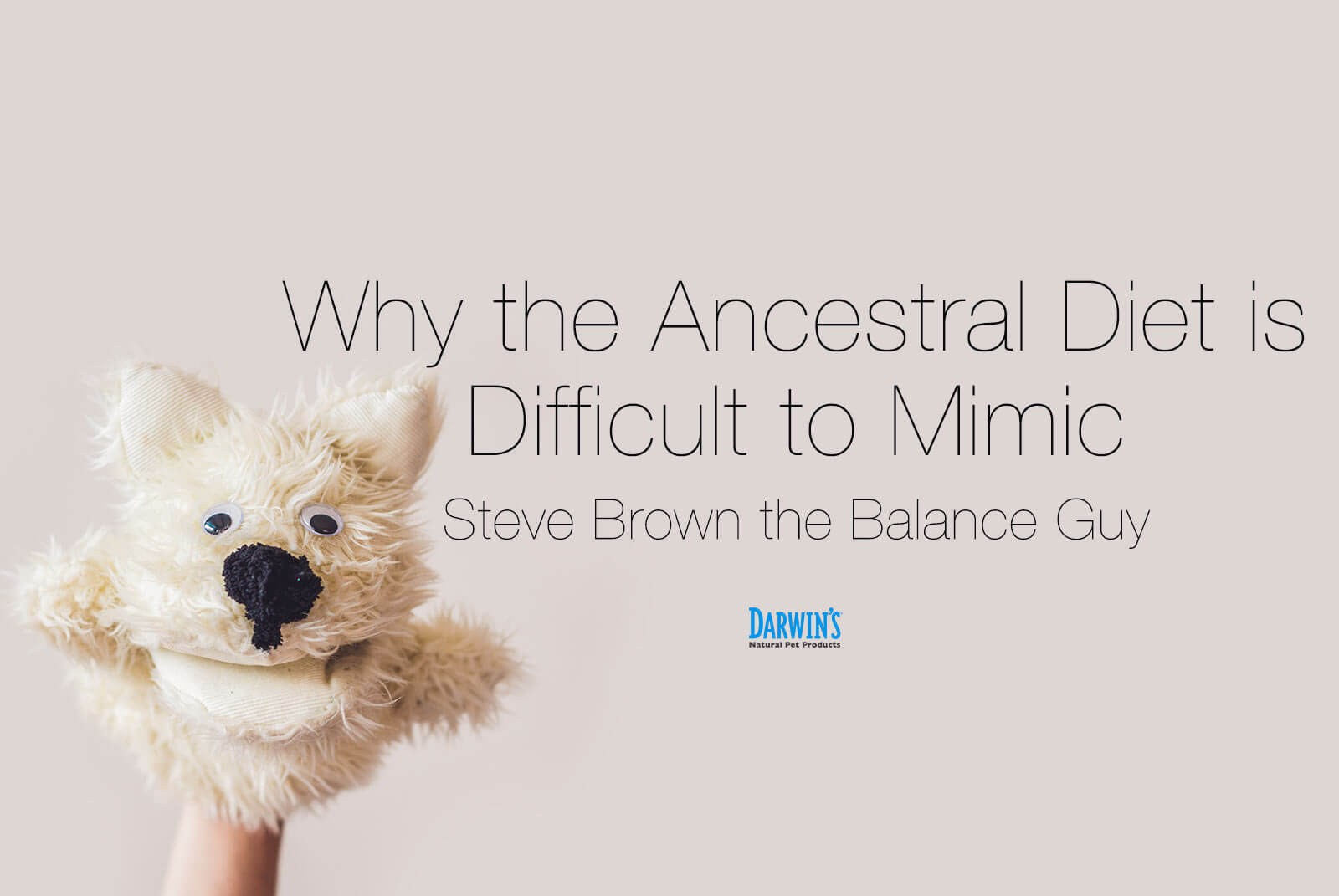The Dog’s Ancestral Diet
6/30/16


Why It’s Difficult to Mimic
Recent nutritional science increasingly supports a whole food, ancestral-type diet; high protein, balanced fats, mineral and antioxidant rich—as the healthiest approach to feeding most dogs and cats. I see the effects of an ancestral-model diet generation after generation with my dogs.
Each generation seems to get healthier, more intelligent, and calmer.
In The Ancestral Diet for Dogs published in May of 2015 I discussed the ancestral diet of dogs, and its macronutrient content (the protein, fat, moisture, carbohydrate) compared with typical dry foods. In this blog, I provide more detail and discuss why it is difficult to mimic the ancestral or “prey-model” diet. This is essential reading for all those trying to feed their dogs their natural diet.
I am very detailed in my definition of the ancestral diet. Success is in the details. Making an ancestral or prey-model type diet depends upon paying attention to the details.
To be clear, there is no one ancestral diet for dogs.
Diets of our dogs’ ancestors varied tremendously by location, time of year, sex, health status, availability of prey and other foods, and many other factors. But I have enough data to make some rather detailed conclusions.
The dog’s ancestral diet consisted primarily of whole prey animals.
Including fish, and contained grasses, fruits, eggs, nuts and practically anything that can remotely be considered edible. Note that whole means all the organs and glands, including the skin, fur, and coat for smaller animals. It does not mean just backs, nor does it mean a large meal of just liver.
Our dogs’ ancestors were probably always aware of the possibility of starving to death, they overlooked no food. Our present dogs are not the same, my dogs have probably never worried about starving to death.
Looking at the ancestral diet in more detail.
We see that it is high protein, moderate fat, low carbohydrate, with high intra-cellular water, the water within the cells. About 49% of the calories were from protein, 45% from fat and 6% from carbohydrates. The ancestral diet contained roughage and non-digestible parts, had a high mineral content, and, unlike kibble, a full range of vitamins and antioxidants.
(The protein and fat content is a yearly average, with typical prey being fattier in the fall and leaner in the spring, but never a lot of fat. Even the fattest prey in the best of years had a lot less fat than do our feed-lot fed animals.)
If you are trying to mimic the ancestral model or prey-model diet should pay particular attention to the macronutrient content of the typical ancestral diet, tables 1 and 2.


The ancestral diet was mineral rich, something that is nearly impossible to achieve using the part of domesticated feed-lot or pasture fed animals that are available. Table 3 compares typical ancestral standards with AAFCO minimum recommendations. Ancestral standards are much more demanding.

Why is it difficult to meet ancestral standards?
It’s important for those who are attempting to mimic the ancestral or prey-model diets to know why they can’t just give their dogs bones, cheap ground beef and occasional organs and expect it to be “prey-model.” There are two reasons: first, wild prey (table 4) and game meats are a lot leaner and mineral-rich than are domesticated feed-lot fed animals of the same species, and second, most people, including most commercial companies, can’t get the super mineral-rich parts of the animals such as the hair, wool, feathers, adrenals, pituitary, testes, ovaries, prostate, eyes and so forth.

When formulating, these look like two totally different animals. The differences in the mineral composition of wild duck compared to domesticated duck is equally large; for example, the domesticated duck has less than 50% of the manganese per 1000 kcal of the wild duck. Wild ducks – let’s call that the prey-model diet – is much more mineral-rich than are domesticated ducks. One can’t mimic feeding wild ducks by just feeding domesticated ducks.
One can readily see the differences between wild animals and modern food animals by looking at the USDA data for game meats, table 5.

Remember game meat is lean.
Another reason why it is difficult to mimic the ancestral diet with domesticated animals is that some of the most mineral-rich parts of animals are difficult for people and commercial raw diet companies to source. These parts include the thyroid, thymus, pineal, prostate, ovaries, eyes, brains, testes, pituitary, adrenals, hair, and feathers. For example, hair, feathers and wool, parts that are difficult to obtain and use, contain six to ten times more manganese (measured in ppm) than do organs and muscle meats.[i]
Manganese (Mn), Zinc (Zn), Copper (Cu), and Iodine (I) are the trace minerals, vitamins D and E are the vitamins that I almost always need to worry about with fresh meat-based diets. I discuss these nutrients and other nutrients later in the Focus on Nutrients series.
Want Steve’s previous chapters?
– Vegetables for Dogs – Focus on Nutrients Part 1
– “Complete and Balanced” What does it mean to pet food? – Focus on Nutrients Part 1
– Buying Raw Pet Food – Focus on Nutrients Part 1
– Bringing Out the full Health Potential of Your Dog – Focus on Nutrients Part 1
– Steve Brown’s Introduction to Focus On Nutrients Part 1
[i] Mertz, Walter, editor; Trace Elements in Human and Animal Nutrition, 5thedition, vols. 1 and 2, Academy Press, 1987.
 Steve Brown is a dog food formulator, researcher, and author on canine nutrition. In the 1990s he developed one of the leading low-calorie training treats, Charlee Bear® Dog Treats, as well as the first AAFCO-compliant raw dog food. Since 2003 he has focused on research and education. He is the author of two books on canine nutrition (See Spot Live Longer, now in its 8th printing, and Unlocking the Canine Ancestral Diet (Dogwise Publishing, 2010); and a 40-page booklet, See Spot Live Longer the ABC Way.
Steve Brown is a dog food formulator, researcher, and author on canine nutrition. In the 1990s he developed one of the leading low-calorie training treats, Charlee Bear® Dog Treats, as well as the first AAFCO-compliant raw dog food. Since 2003 he has focused on research and education. He is the author of two books on canine nutrition (See Spot Live Longer, now in its 8th printing, and Unlocking the Canine Ancestral Diet (Dogwise Publishing, 2010); and a 40-page booklet, See Spot Live Longer the ABC Way.



